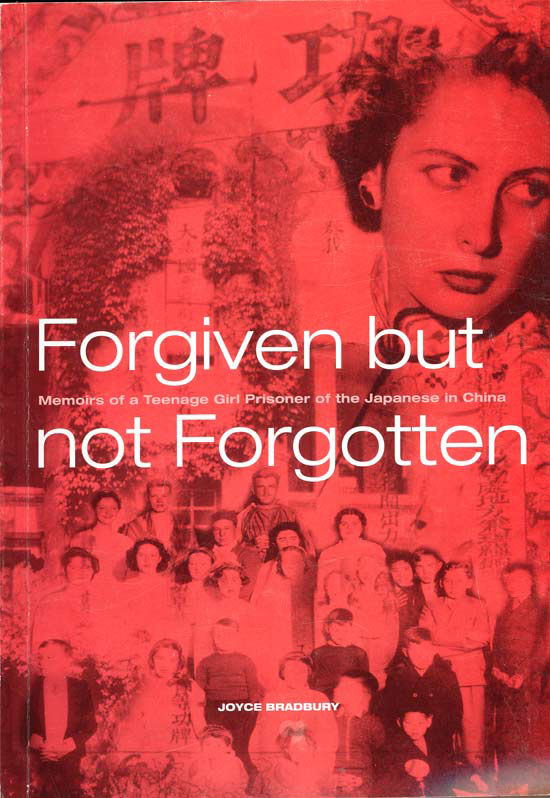
- by Joyce Bradbury, née Cooke
[Excerpts] ...
[...]
 The new camp was formerly an American Presbyterian missionary training centre. Its buildings included a well-built church, a hospital, dormitories and two-storey houses surrounded by a brick wall on which there was barbed and, later, electrified wire.
The new camp was formerly an American Presbyterian missionary training centre. Its buildings included a well-built church, a hospital, dormitories and two-storey houses surrounded by a brick wall on which there was barbed and, later, electrified wire.
There were machine-gun posts at intervals on the walls. On arrival we were allotted rooms. In our case we were given one room sized about 3 metres by 4 metres for my parents, young brother and myself. Upstairs were the de Zutter family from Tsingtao.
Unaccompanied single persons were put into same-sex dormitories.
Wei-Hsien is a hot-and-cold place. It has snow in the winter and can be boiling hot in the summer. It is inland and about 120 kilometres west of Tsingtao. Outside the camp, there was farm land on which there were market gardens.
Because for three-and-a-half years we did not leave the camp, I cannot describe what the farmers did and what the nearby town area was like.
When we arrived, the camp was in very bad condition because it had not been used for some years.
It had earlier been looted by Chinese bandits or Communist forces before the Japanese Army took control of it.
The camp’s toilets were all blocked or inoperable.
There was rubble everywhere.
[excerpt]
Our group was the first Japanese internment prisoner batch to arrive in the Wei-Hsien camp and thus we bore the brunt of the camp’s initial cleaning up.
As the days went on, some 500 Catholic priests, brothers and nuns arrived together with clergy from a diverse mix of other denominations.
About 1500 more civilian internees were also brought to the camp. For the first few weeks, we had a big clean-up and committees were formed to set up and staff schools, the hospital, a bakery, a shoe repair shop and kitchens.
[excerpt]
As we began to settle down, the various committees allocated duties to everybody over the age of 14.
Doctors and nurses were assigned to hospital duties and caring for the health of people while tradesmen worked in the carpentry and other shops. In general, the women had to peel vegetables and the men worked in the kitchens irrespective of their former callings.
[excerpt]
I lost weight but otherwise remained healthy except for tinea of my toes for which one of the doctors gave me Condy’s crystals which helped heal them. My brother went to the camp hospital and received treatment for a cut lip.
During our imprisonment my brother was still recovering from tuberculosis. The doctors handled limited supplies of milk and eggs for babies and children under 10. Because Eddie turned 10 at Wei-Hsien, he did not qualify for the milk and eggs. This annoyed my father who thought he should receive milk and eggs to help him recover.
Pop was working in the cookhouse one day wondering how he could get nourishing food for Eddie when a pigeon flew in through a window and fell into a vat of boiling soup. In no time it was plucked, cooked and fed to my brother.
Pop always said the impromptu pigeon meal saved young Eddie’s life.
[excerpt]
The medical doctors and nurses ran the camp hospital with great efficiency.
There were many patients with illnesses and injuries. On one occasion late in the war, some medical drugs came to the camp hidden in Red Cross parcels. We were told the Japanese removed the labels from the containers. The absence of the labels was very troublesome because our doctors had to try to analyse the contents to find out what they were. Some of these drugs were the then new and highly effective anti-bacterial sulpha drugs. I have recently been told that the drugs were hidden in the Red Cross parcels by Chinese Nationalist forces who had received them at their nearby base from an Allied air drop. The drug labels were removed to prevent them being detected by Japanese searchers when the Red Cross parcels were delivered to the camp. A short time after the drugs were delivered, Father De Jaegher obtained information on the dispatched drugs from the Chinese Nationalists and their recommended methods of usage which he gave to the hospital doctors. The doctors and those who assisted them in the hospital did a splendid job for the inmates. They also treated the Japanese when they needed medical attention.
[excerpt]
The compound still exists and from what we could gather it is now a hospital. Stan met one of the Chinese who used to black-market deal with him during the war. The insulator cups from the electrified wire fences are still on the compound walls and many of the buildings are still in use. The hospital, church and Japanese officers’ buildings still stand. We located the kitchen where my father worked.
Memories flooded back for Stan and me.
[excerpt]
In her report, Dr Wagner makes the point that the American-held enemy internees were well treated in Texas and that comparison of their conditions with those at Wei-Hsien were as different as chalk and cheese.
Some parts of her recollections of Wei-Hsien differ significantly from mine. The differences, I suggest, are largely due to the camp’s Japanese regime becoming stricter and meaner to the inmates from late 1943 until our liberation.
Because of the significance of Dr Wagner’s comments about how she saw Wei-Hsien, I have included them in this book. Her comments have not been published in a book about the camp. Where necessary, I have paraphrased Dr Wagner’s report.
Dr Wagner wrote of Wei-Hsien: “Situated between Tsinan and Tsingtao in the Interior of Shantung, about 150 miles south-east of Tsinan.
The camp is located on the premises of the former Presbyterian Mission compound. The compound is situated about two miles from the town, Wei-Hsien. The compound was attractively landscaped with shrubbery and fine old shade trees, some 60-year-old. The climate is pleasant in the spring and fall [autumn].
“The summer heat begins in May, reaching its climax in the month of August. The rainy season begins in August. Heavy rains lead to roads being flooded, walls collapsing and flood waters reaching the window sill level of many houses. Rooves leaked. Rain poured into dormitory rooms, kitchens and mess halls. Winters cold and fairly dry. Bitter cold in December, January and February, moderating somewhat in March, but still cold.
“Wei-Hsien is probably as hot as [the Texas Crystal City] desert camp in the summer, but the heat is humid. The trees at Wei-Hsien provide some relief and shade from the heat indoors, which is not true of the [Crystal City] camp visited. The winters in Wei-Hsien are undoubtedly much, much colder than the winters at the [Crystal City] camp.”
Dr Wagner says when she left the Wei-Hsien camp there were 1800 internees.
[excerpt]
“Dormitory rows of single rooms assigned to families. Rooms 9 feet by 12 feet [about 1.5 metres by 2 metres] containing two to four persons, depending on size of family.”
[Accommodating]
Four persons barely possible in summer. If there is to be a stove in room in winter, [it is] impossible for four [people].
“Armies had previously occupied buildings.
Buildings in disrepair, wind and dust swept through cracks and crevices. Difficult to keep warm in winter. The walls were whitewashed and floors painted in preparation for internees. Many of the rooms infested with bed bugs and fleas. No beds, cots, tables, chairs provided.
Internees were permitted to bring bed and bedding.
Internees who were transferred from Chefoo to Wei-Hsien just before we left [for repatriation] were not permitted to bring their beds, [they] were sleeping on the floor.
No running water or toilet facilities. Space available per person 34 to 54 square feet [3.2 to 5 square metres.] Official allowance is 45 square feet.
“Stoves [March 1943] in only a few quarters — [for the] aged, small children, sick. Small stove in large dormitory rooms totally inadequate. No kindling wood or paper provided. Coal had to be picked by hand from coal heap, considerable distance away. No containers for carrying provided.”
For washing, toilet and laundry facilities, Dr Wagner reports that the Wei-Hsien facilities contained: “Four blocks of 5 and 6 toilets each, Japanese squat type. Originally meant to flush, but never had tanks connected. Inconveniently located. So close to some buildings that the dormitories were never free of the toilet and cesspool stench, so far away from other buildings as to require a long walk in the outdoors to reach them.
23 toilets in all for 1800 people [resulting in] morning and evening long queues. In reality, [toilet availability] average was more nearly one to 100 people as some of the toilets were continually out of order. The water supply was so limited that very little fresh water was allowed for flushing toilets. Internees brought their own slop water and deposited it in two earthenware jars at the entrance to the toilet block. Used empty tin cans to flush toilets.
“Drain pipes leading to cesspools small and frequently clogged. [Because] cesspools had inadequate depth and diameter [they] usually overflowed, flooding surrounding areas with filth and stench. Chinese coolies finally allowed to come in regularly to empty Chinese latrines and to carry away some of the contents of the cesspools.
“All requests to be allowed to dig deep army-style open latrines turned down repeatedly. In August [1943] buildings containing flush toilets finally screened. No screens [on] Chinese-style toilets. Swarms of flies in toilets and around cesspools.
“No toilet paper supplied by authorities, except for a few months to hospital [and inmates had] great difficulty in getting disinfectant and cleaning materials.”
Dr Wagner reports there were “four washrooms in toilet buildings. A number of faucets arranged over cement troughs. Only a trickle of water occasionally available. 90 per cent of internees used hand-basins in own quarters ― carrying water from one of several wells.”
Shower facilities consisted of “one shower room for men, one for women with about 14 to 16 shower heads in each. Average one shower for every 60 persons.
“Showers [were the] only place [where] running hot water available. Because of limited amount of water, women only permitted three showers a week, men daily showers. Long queues [for showers] and there was no running water in any living quarters.
Laundry facilities consisted of “five stationary tubs in hospital basement and two in another building. Internees did their laundry in hand-basins and galvanised tin pails (if they could borrow one). Later, [it became] possible to send sheets, towels, pillowcases, heavy clothes to laundry outside. Expensive and badly done. Not many could afford this.”
On medical facilities at the camp, Dr Wagner notes the “hospital at Wei-Hsien was originally a fine little hospital. When internees arrived, only the outer shell left. Everything moveable had been taken away. Great big gaps in the wall where pipes had been torn away. Place littered with many months accumulated filth and debris.
“No cleaning materials or equipment provided by authorities. Nurses, doctors, internees went to clean up the place, [they] were able to find enough beds for three 12-bed wards, five beds for children, an obstetrical room. Patients brought their own mattresses, bedding, linen, wash basins, etcetera.
“Internees accumulated enough equipment for four outpatient clinics [which were] rather sketchily furnished.
[Internee] “doctors gave Japanese authorities list of drugs needed, nothing resulted except a few minor drugs. Copy of list was smuggled out to Swiss representatives who in July [1943] got the drugs, along with some cereal and tinned milk to the hospital.
Each person in camp was assessed by internees’ committee $60 [Chinese] to pay for his share of cost.
“Japanese eventually furnished a rather cheap operating table, a gasoline burner without gasoline, surgical equipment enough to open a boil, some mattress ticking, some sheets, some gauze.
“Hospital facilities and equipment dangerously inadequate together with lack of drugs when those on hand used up [because] Wei-Hsien is in an isolated community of no hospitals. Permission was given for patients to be taken to Peking ― a long, dirty, difficult, expensive journey.
“Medical situation serious ― save for good doctors and nurses among internees. None supplied by Japanese.
On Wei-Hsien’s cooking facilities, Dr Wagner says: “There were three mess halls with attached kitchens and a small hospital diet mess hall [for patients]. The Peking mess [indicating where the internees were first assembled before Wei-Hsien] served 400 to 440 people, Tientsin mess 600, Tsingtao mess 800.
“A small storeroom and butchery were assigned to each kitchen. In the case of the Peking kitchen [it was] a distance away. A family-size electric refrigerator and an icebox were eventually installed in the butchery.”
Dr Wagner writes: “A result of the lack of refrigeration [meant] much food had to be discarded because of spoilage. The camp suffered from epidemics of diarrhoea and [what] appeared to be dysentery.
“There were no equipped, stocked, refrigerated warehouses. A former residence was used as a central storage house. Vegetables, meat and fish rotted and spoiled because of poor storage.
“At the end of [the 1943] summer, permission was granted [by the Japanese] to internees to build an icebox for general storeroom for meat” which was “poor, makeshift. [The] Japanese storekeeper [was] inadequate for the job. Finally, persuaded [Japanese] ... to allow internees’ supply committee to divide food among mess halls.
“Meat came from army slaughterhouse 30 miles away. [It was] sent by train, unrefrigerated, often uncovered. Rooms for preparation of meat swarmed with flies, meat covered with larvae in a brief period of time necessary for preparation. “Kitchens painfully small. Kitchen where food for Peking internees was prepared was no larger than a kitchen in a modern American small apartment. But there was nothing modern about the kitchen. [It] contained a Chinese stove, no oven, two large cauldrons with fire boxes underneath, a ledge about 1.5 feet [0.5 metres] wide on which to place things, a sink without running water. The only equipment consisted of two large frying pans, two family-sized copper pots, some galvanised tin pails [of] poor quality, a dozen paring knives, 4 bread knives, a couple of crocks and bowls. Everything else in kitchen equipment — knives, forks, ladles, plates, bowls, pans, beaters, grinders and containers — provided by internees.”
There was running water in two of the kitchens. In others, all water used in cooking, cleaning and drinking had to be pumped, carried and boiled in two cauldrons at the far end of the mess hall — well away from the kitchen areas.
“Dining room tables and benches [were] badly made of poor wood, difficult to keep from falling apart and difficult to keep clean. Seating space inadequate”, resulting in “long queues” and “two and three sittings”, for each meal.
“Occasionally, a mop or broom for cleaning was issued by authorities but never without a struggle. Internees furnished cleaning cloths, soap, powder, etcetera where they had it to spare.
“Authorities were given lists of equipment needed in the kitchen and for preparation and serving of food. Nothing ever came of this.
“Below is the quantity of food in ounces supplied per day [1 ounce or 1 oz equals 28.3 grams]. Often it was necessary to discard considerable amounts of meat and vegetables [because it was] unfit for human consumption.
“Meat 5 oz, potatoes 10.2 oz, vegetables 13.6 oz, bread 16.6 oz, sugar 0.6 oz, margarine 0.2 oz, fish 0.8 oz, tea 0.1 oz, coffee substitute 0.1 oz, jam 0.03 oz, flour 0.2 oz, oil 0.4 oz,” and less than one-eighth of an egg per person a day.
“Actual caloric intake 1905 [one calorie equals 4.855 joules], of which 1175 was from flour in some form.
“Calcium [intakes] inadequate. Egg shells salvaged and ground to supply calcium. No milk except as issued by hospital. At the highest point, 35 gallons sour milk for 1800 people. Usually 25 gallons per day.” [1 US gallon equals 3.785 litres.]
As Dr Wagner shows and I have written in Chapter 5, Wei-Hsien in 1943 was no holiday camp. In my recollection, inmates’ conditions worsened in 1944 and 1945.
Finally, to one other matter that has intrigued many about the Wei-Hsien camp. Since the late 1940s, it has been claimed that the US aviatrix, Amelia Earhart, was interned in the camp. Earhart disappeared pre-World War II while on a Pacific journey. It was suggested she was seized by Japanese officials because she had allegedly used her flights to spy on Japanese military preparations on small Pacific islands.
The claims say she was later interned with us, hid in the camp hospital and either died there, or was spirited away by the Japanese before the end of World War II and executed.
As I have shown, we lived cheek by jowl in the camp. Never once in the camp or since have I heard from fellow inmates of a top-secret prisoner in the camp or Amelia Earhart being in the camp. None of those I have questioned heard of the story in camp and none has been able to give any credence to the suggestions that we had Amelia Earhart among us. If she was among us, we would have quickly identified her because she, before her disappearance, was one of the world’s most photographed women.
[further reading]
http://www.weihsien-paintings.org/HOAX/AmeliaEarhart/p_AmeliaEarhart.html
http://www.weihsien-paintings.org/books/ForgivenForgotten/Book/ForgivenNotForgotten(WEB).pdf
#








